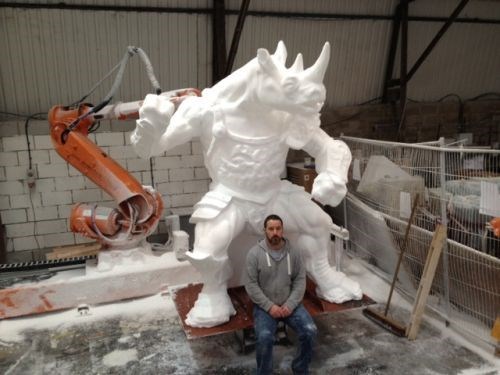Machining with Robots
Several exhibitors at the recent EMO show in Hannover, Germany, featured demonstrations of robotic arms wielding live cutting tools such as end mills or face mills. Perhaps the most dramatic demo was presented by Delcam to showcase this CAM developer’s PowerMill Robot Interface.
Several exhibitors at the recent EMO show in Hannover, Germany, featured demonstrations of robotic arms wielding live cutting tools such as end mills or face mills. Perhaps the most dramatic demo was presented by Delcam to showcase this CAM developer’s PowerMill Robot Interface. The interface is designed for programming robots to do multi-axis machining operations. The demo consisted of two FANUC robots working together to carve the rhinoceros-like head of a greatly enlarged fantasy action figure. On robot manipulated the pallet-mounted workpiece, while the other robot maneuvered the powered end mill.

Simulation of robotic motion enables the programmer to optimize machining operations.
This new robot interface is an application embedded inside the company’s PowerMill CAM system as a plug-in. This approach makes it as easy to program a robot for machining as it is to program a five-axis machine tool, the company says, as demonstrated in this video.
The core functionality of the interface consists of three main steps: programming, simulation (including analysis) and creation of the robot programs. Robots can be programmed for tool-to-part applications, such as machining large parts or trimming composite panels. Robots can also be programmed for part-to-tool applications, such as grinding or finishing. The interface can then be used to simulate the complete machining operation and to control the robot’s movements through different variables, such as axis limits, axis priorities and workplane constraints. The simplified workflow makes it easy to program, simulate, review and refine tool paths, while enabling the robots to achieve levels of accuracy similar to many CNC milling machines when cutting softer materials.
Once the results of the simulation have been reviewed, and modified if necessary, the program can be output in the appropriate robot native language, including KUKA, ABB, FANUC, Yaskawa Motoman or Stäubli equipment. This eliminates the need for third-party translation software.

The rhino head machined at EMO is a copy of the one that tops this completed piece produced by CNC Polystyrene, a model studio in the UK.
Related Content
-
Weiler to Debut New Automation Features For Its Lathes
Weiler’s V 110 four-way precision lathe introduces features new to the U.S.
-
Zero-Adjustment Bar Pullers Simplify Turning Automation
Spring-loaded grippers and adjustable programming are enabling bar pullers to fulfill their promise to save time and money in CNC turning automation.
-
Modern Bar Feeds Bring New Life to Automatic Swiss Lathes
Cam-actuated Swiss lathes are still the fastest way to process many parts. By adding modern bar feeders, this shop has dramatically improved their utilization with the ability to work unattended, even in a lights-out environment.















.png;maxWidth=300;quality=90)
